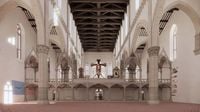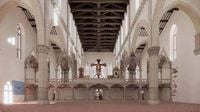In a groundbreaking collaboration, the Opera di Santa Croce and the University of Florence have embarked on an ambitious project aimed at unraveling the rich history of the Santa Croce complex. This partnership, which has been in place since 2019, seeks to enhance the understanding and appreciation of this monumental site, which has stood as a testament to centuries of art and architecture.
The results of their research were highlighted during a recent presentation held on April 2, 2025, in the Cenacolo of Santa Croce. Key figures in this initiative, including Stefano Filipponi, the Secretary General of the Opera di Santa Croce, and Alessandra Petrucci, the Rector of the University of Florence, discussed their findings alongside faculty members Fulvio Cervini and Emanuela Ferretti.
The culmination of their efforts is documented in the newly released book, Santa Croce tra passato e futuro – Conoscere, conservare, condividere, which translates to "Santa Croce between Past and Future – Know, Preserve, Share." This publication marks the second volume in the Voci di Santa Croce series, reflecting the ongoing commitment to both preserving and promoting the historical significance of the basilica.
One of the most fascinating aspects of this research has been the virtual reconstruction of the monumental rood screen, a significant architectural feature that divided the basilica into two distinct areas. This screen, originally constructed in the mid-1300s, was an impressive structure standing at 4.82 meters high and featuring nine bays with a central opening. Utilizing tools from the Digital Humanities, researchers have created a detailed 3D model that allows for immersive navigation, enabling visitors to explore the space as it might have appeared centuries ago.
As part of this reconstruction, the project has also led to the reclassification of several stained glass windows within the basilica. Notably, figures of Moses, David, Aaron, and Solomon in the lower part of the central window of the main chapel have been attributed to the renowned artist Giotto. This finding not only enhances the understanding of the artwork but also connects it to the historical narrative of the basilica.
Additionally, the research team has shed light on the earlier iteration of Santa Croce, which was significantly smaller than the current structure. Remains of this earlier version were uncovered during excavations in 1967, providing valuable insights into the evolution of the site over the centuries.
The collaboration between the Opera di Santa Croce and the University of Florence is not just about historical inquiry; it also aims to engage younger scholars and promote interdisciplinary study. Giovanni Pescarmona and Giuseppe Costanzone, under the guidance of the scientific committee, have conducted digital surveys in the underground areas of the basilica, leading to new structural hypotheses about the monument.
For the first time, the project has successfully represented the rood screen and its placement within the basilica through a two-phase process involving digital surveying and virtual modeling. This innovative approach allows for a deeper understanding of the spatial relationships within the complex and the artworks that adorned it.
Among the artworks believed to have been displayed on the upper level of the rood screen are the large Crucifix by the Master of Figline, the Pala Bardi by Coppo di Marcovaldo, and the Maestà by the Master of Figline. Furthermore, the possible inclusion of the Stigmatization of Saint Francis by Taddeo Gaddi adds another layer of historical significance to the project.
The visual ensemble of the basilica was further enriched by the murals that adorned its walls. However, many of these have been lost over time, complicating efforts to reconstruct the visual richness that once defined the space. Notably, the eschatological cycle by Andrea Orcagna, depicting the Last Judgment, the Triumph of Death, and Hell, remains a focal point of interest. Fragments of these works have been discovered behind the altars of the 16th century and are currently housed in the Cenacolo.
This extensive research effort aims to create a new narrative that makes the history of Santa Croce accessible and engaging for visitors. By reconstructing the connections between the space and its artworks, the project hopes to foster a deeper appreciation of the basilica's cultural heritage.
In this methodological context, Giovanni Giura has reconstructed the original location of Donatello's Crucifix from the early 1400s, placing it in the fourth bay near the rood screen. Meanwhile, Alessandro Grassi has traced the history of the Pala Bardi and the Maestà, detailing their movements and placements throughout the centuries.
The findings from this collaborative effort not only contribute to the academic understanding of the Santa Croce complex but also serve as a foundation for enhancing visitor experiences. The ongoing project aims to redefine how the site is presented to the public, ensuring that the rich tapestry of history is woven into the visitor experience.
As the Opera di Santa Croce continues to develop its new visitor reception area, which has already seen improvements in the Cenacolo and the Cappella Cerchi, the research findings will play a crucial role in shaping the narrative of the complex. This initiative reflects a broader commitment to preserving the legacy of the Franciscan community in Florence and ensuring that their contributions to the city’s cultural landscape are recognized and celebrated.
In summary, the collaboration between the Opera di Santa Croce and the University of Florence represents a significant step forward in the understanding and appreciation of one of Italy's most iconic monuments. Through innovative research and the application of Digital Humanities, the project not only preserves the past but also engages future generations in the ongoing story of Santa Croce.





